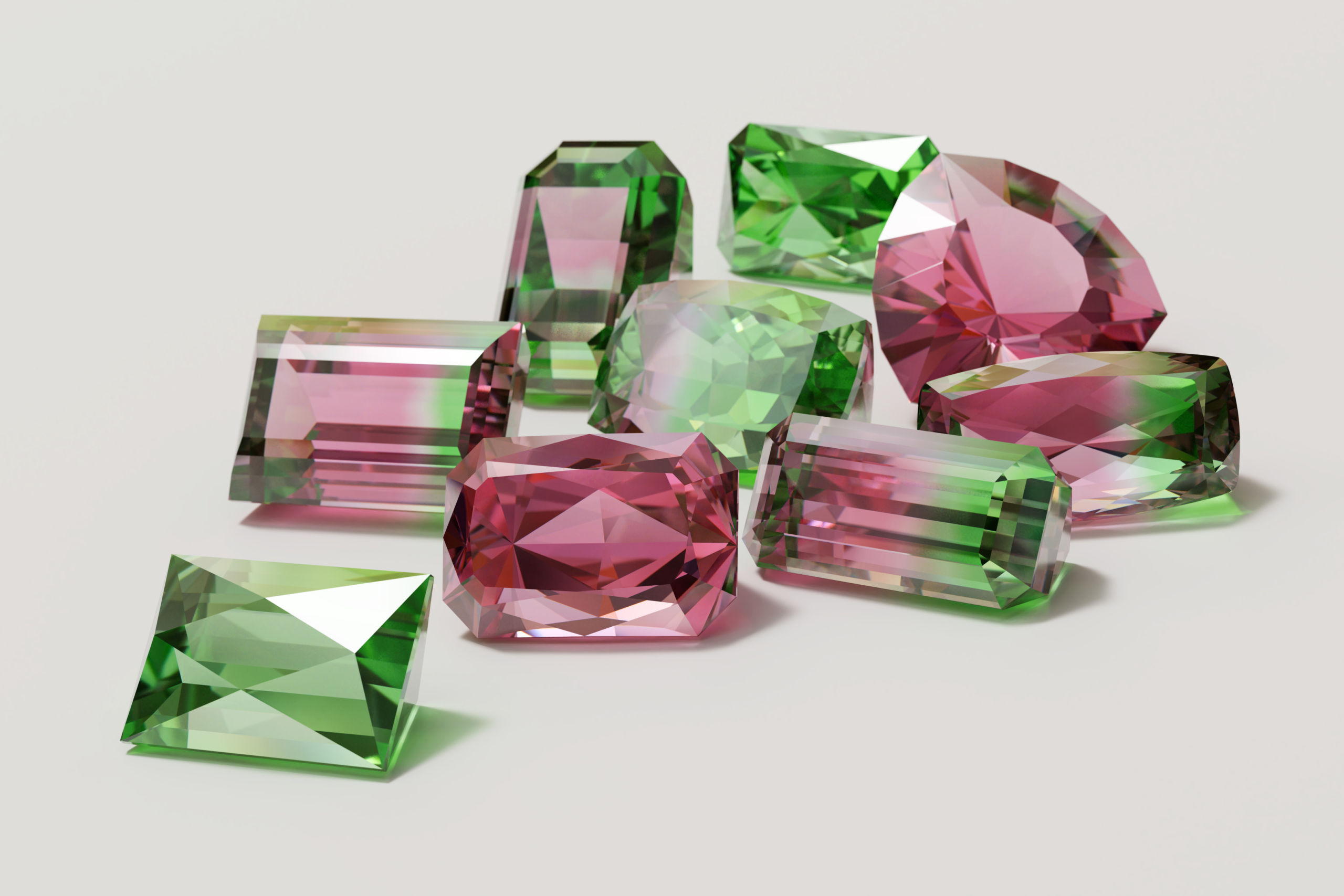 Tourmalines have, for centuries, been captivating collectors with their varied and uniquely intense colors. Historically, they eluded identification and instead were attributed as everything from rubies and emeralds to topaz, peridot and sapphires. Tourmalines are a complex and interesting family of gemstones.
Tourmalines have, for centuries, been captivating collectors with their varied and uniquely intense colors. Historically, they eluded identification and instead were attributed as everything from rubies and emeralds to topaz, peridot and sapphires. Tourmalines are a complex and interesting family of gemstones.
Each color group of Tourmaline has its own market of desirability, but color and clarity generally impact the value of Tourmalines the most. “Eye clean” stones with strong color will routinely command the highest prices per carat. Though the gem cutter strives to keep the inclusions to a minimum in the final polished stone, the inclusions do not detract from the value in the same way that they do in diamonds.
What color is Tourmaline?
Tourmalines are a family of stones and come in several gorgeous colors. Blue and green Tourmalines are among the most highly sought after. Paraiba Tourmalines, out of Brazil, are currently the most popular of this group. These stones are almost a “neon-blue” as a result of specific trace elements in the stone (whilst a host of trace elements which play a part in the coloration, CuO and MnO must be present in considerable quantities to give this unique color). Mozambique also produces a Tourmaline with similar coloration; they do not yet command the high prices of the Paraiba.
Watermelon Tourmaline (the main image on this post is a Watermelon color with side by side green and pink colors on the same stone), as well as other Tourmalines that feature two, three or more colors, have their own market. They are an interesting sub-set in the family of Tourmalines. These Bi, tri and parti colored Tourmalines are affected in price by their coloring and their cut.
Rubellite Tourmalines, with lively pinks and reds, offer colors not commonly found in other gemstones. Their particular coloring gives them a high level of desirability for a much lower carat cost than similarly colored rubies.
Statistically the rarest color of Tourmaline is the achroite (colorless) gemstone. However, as there is virtually no demand for this particular type, they are the least valuable.
Strong color can carry a stone with obvious inclusions and, based on the rarity of its hue, still demand a high price. Following close behind are the factors of cut and carat size of the gemstone. Stones that are cut well will be symmetrical with well-defined facets. A well-cut stone will highlight the stone’s color intensity and minimize its inclusions.
Do Tourmaline stones have inclusions?
Tourmalines are often included but because of their strong and unique range of colors, the clarity takes a back seat to the color of the stone in terms of their impact on the value. You can find beautiful, barely included Tourmaline stones for a fraction of the price of other gemstones with strong colors similar to Emeralds and Rubies.
What is the best cut for Tourmaline gemstones?
For transparent Tourmalines, a good cut is required to bring out the light and color saturation. With faceted stones, a good cut is defined by crisp facets that line up and give the overall stone a symmetrical shape. When cut well, the Tourmaline’s intense color will be emphasized and inclusions minimized. Poorly cut stones do not try to minimize visible inclusions and allow color saturation to be lost by cutting against the axis.
Are Tourmalines expensive?
Tourmaline demands a lower per carat price than other gemstones with equally impressive color ranges such as Emerald or Ruby and often Sapphire. A 3 carat brilliant green Tourmaline will be a fraction of the cost of similar sized Emerald, and for the price, the Tourmaline will usually have a fraction of the inclusions seen in emeralds.
Are Tourmaline gemstones treated and Enhanced?
Gemstones are often treated and enhanced, Tourmalines are no different. Most often the treaments relate to color or clarity.
Color Treatments
Pale pink Tourmalines are sometimes irradiated to enhance their color to a deeper pink or red. These irradiated Tourmalines typically aren’t valued lower because of the treatment.
Treatments for Clarity
A Tourmaline which has been clarity enhanced is usually negatively affected in its price because of this treatment. Clarity enhancement is when someone tries to “clean up” the inside of a gemstone by drilling or bleaching out inclusions to make a stone appear to be cleaner than it really is.
If you know your Tourmaline has been clarity enhanced, it is important to let your jeweler know so that extra precaution can be taken whenever work is done on the piece of jewelry!
Notable Characteristics of Tourmaline, its History and Mythology
Fun Facts
- Tourmaline can conduct an electrical charge when heated; something as simple as rubbing the stone on fabric can build an electrical charge.
- Tourmaline has long been credited with being able to attract and pickup light substances like straw and ashes. Because of this, Tourmaline was historically used by the Dutch at the ends of their pipes for attracting ash and keeping them clean.
- Slices of Tourmaline have been used in submarine instrumentation and scientific equipment.
- Fascinatingly, Tourmaline itself can be an inclusion inside other gemstones like quartz. These quartz are made into polished gemstones, usually with a domed shape (known as a cabochon) to showcase these interesting Tourmaline inclusions.
History and Mythology
- Until the last few hundred years, Tourmalines were largely misunderstood gemstones. As they appear in every color imaginable, they were often mistaken for other gemstones.
- Intense red Tourmaline cabochons in the Russian crown jewels were thought for centuries to be rubies.
- Deep, intense green, inclusion free (verdilite) Tourmalines were, for years, mined and sold as Emeralds.
- Tourmaline has long been believed to increase the wearer’s strength and creativity. Artists have used them for centuries as inspirational talismans. They were said to give health to nervous systems and the wearer’s blood and help clear and calm the mind.
- Tourmaline is still used today in some high-end beauty products. The crystal is still believed to increase and promote radiance, even when applied to the skin!
If you are looking for a gemstone to sooth your mind, encourage your creativity or a stone that can be found in every color imaginable, then Tourmalines are definitely stones to check out!
